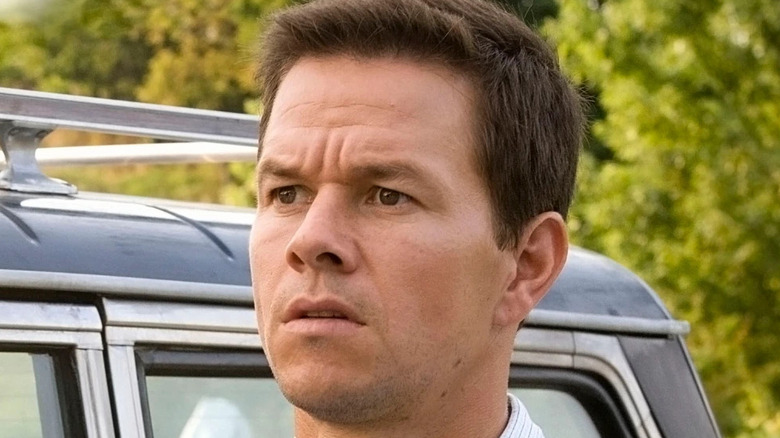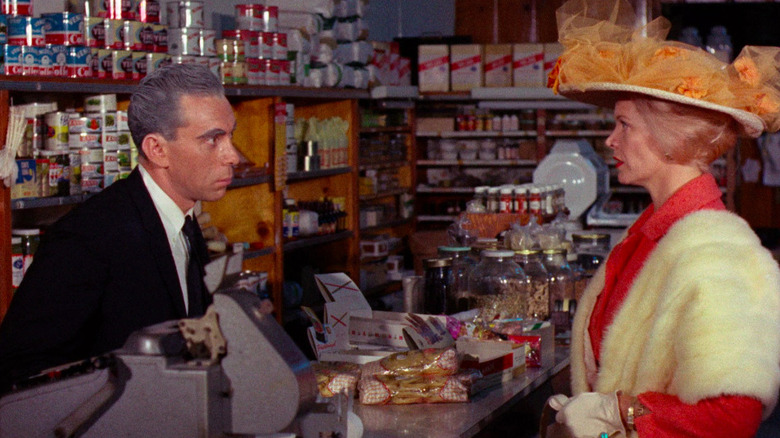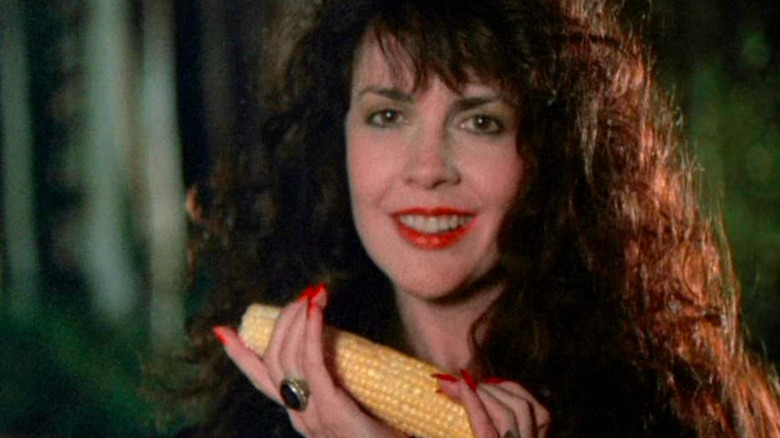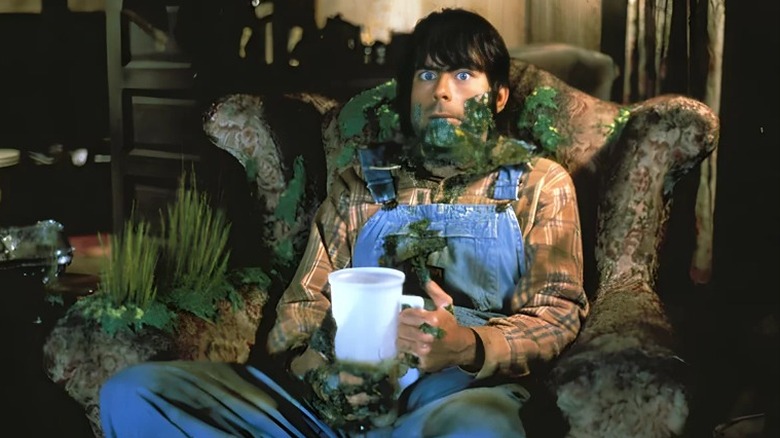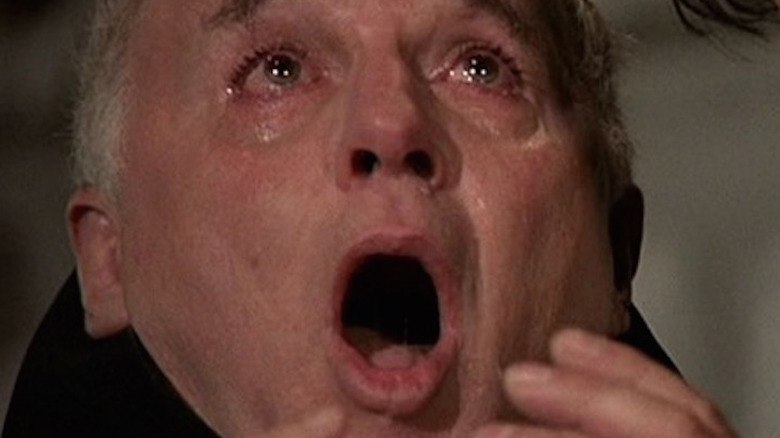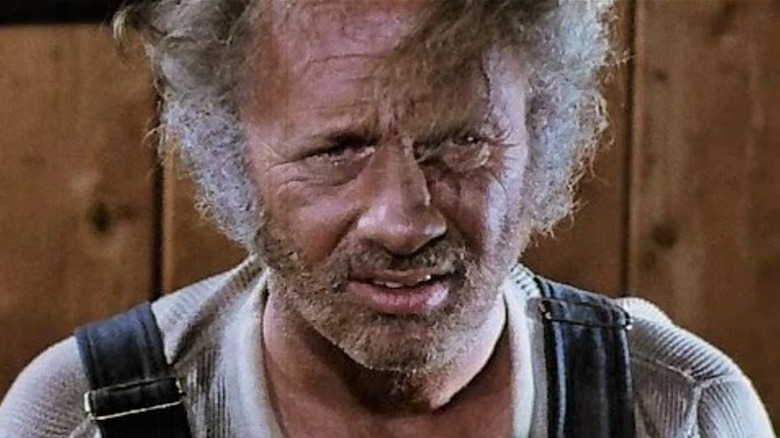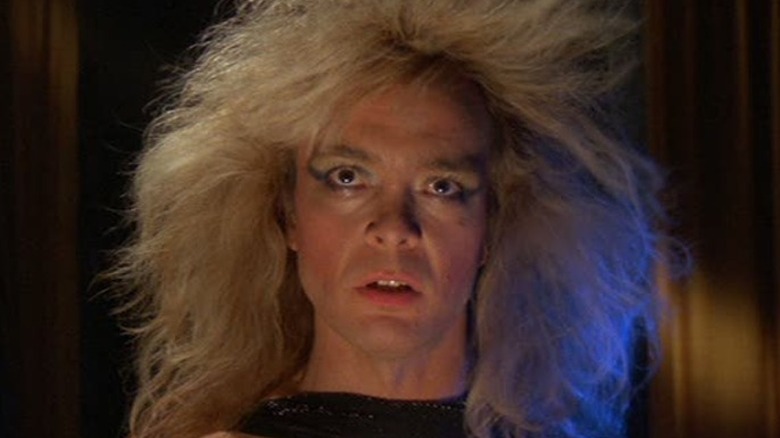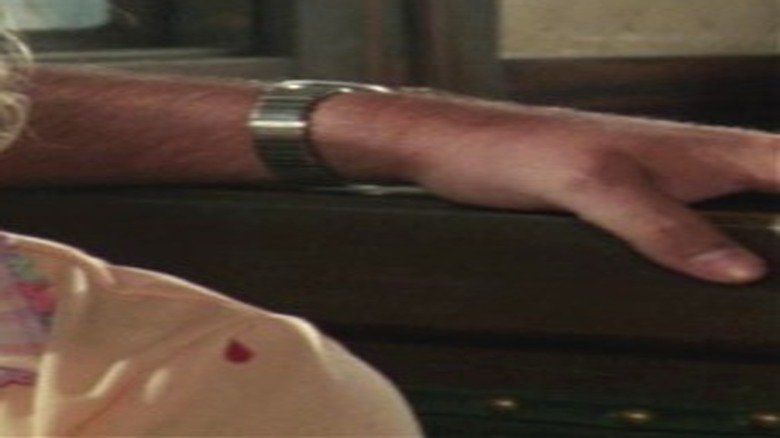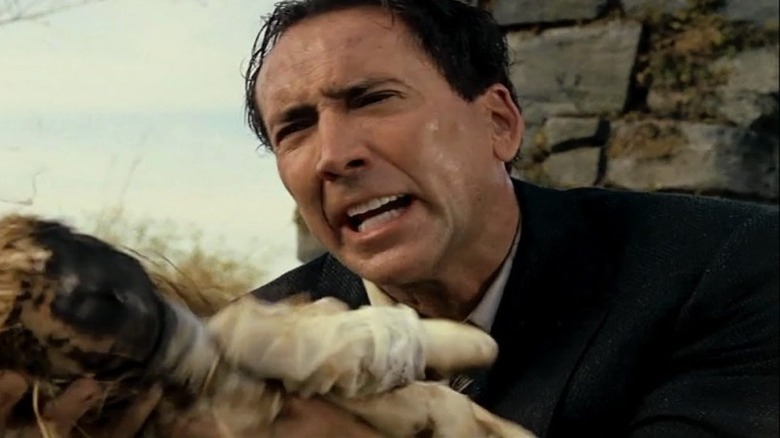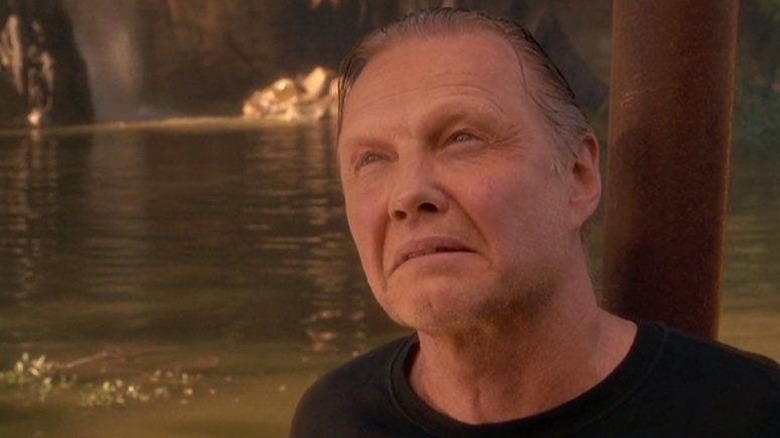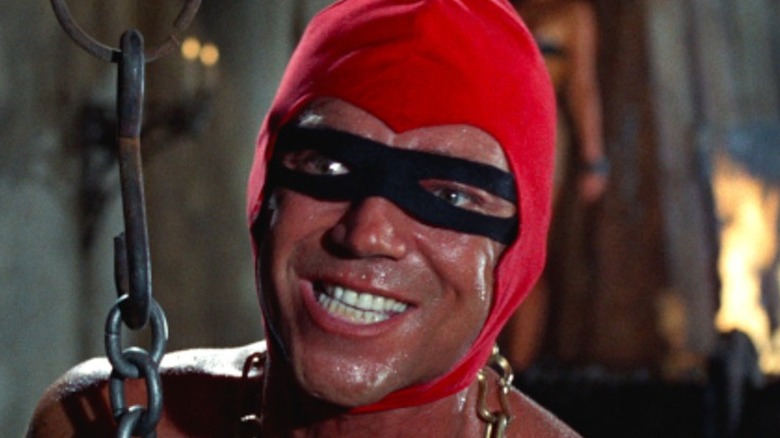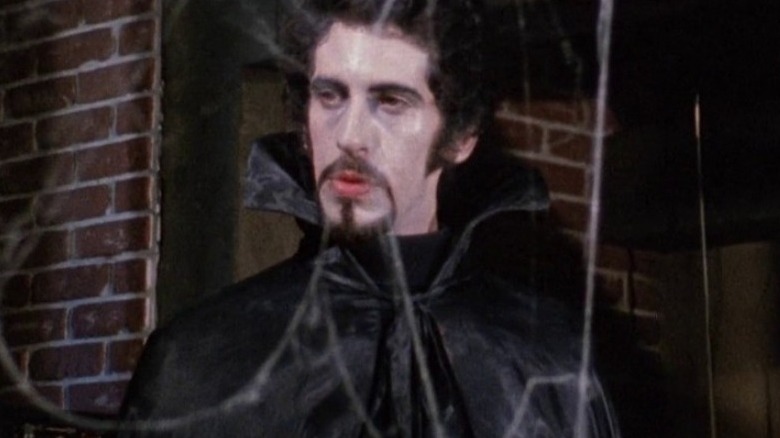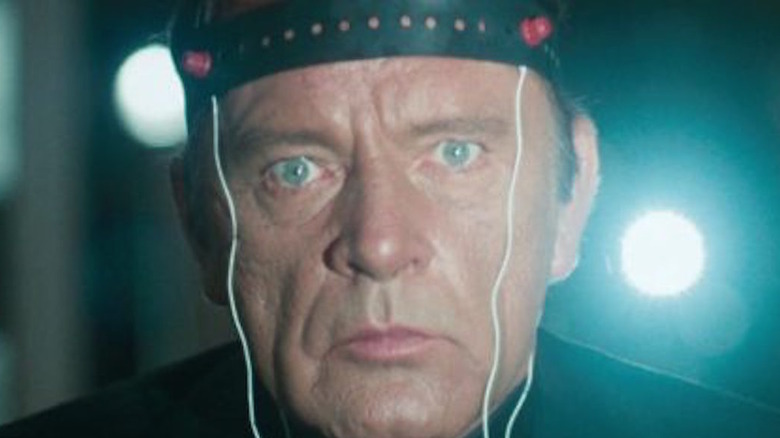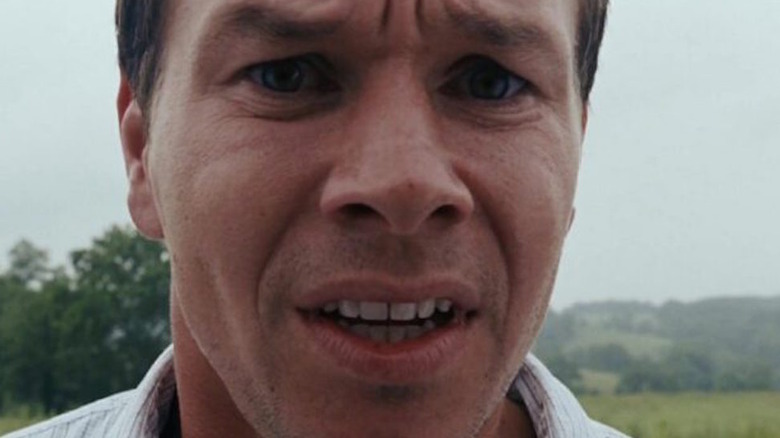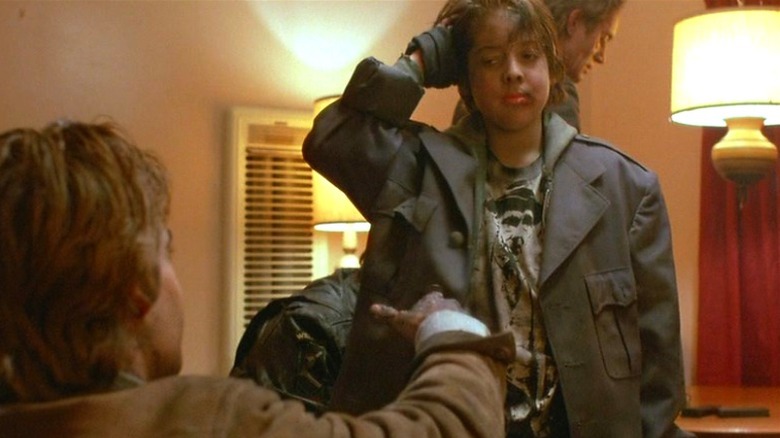Horror Movie Scenes Acted So Badly We Can't Forget Them
We may receive a commission on purchases made from links.
Though all genres require actors to help suspend audiences' beliefs in service of the story, horror ups the ante for performers by asking them to participate in impossible and unreal scenarios and make them not only ring true, but also seem terrifying. Actors playing victims have to enter a state of absolute fright and in some cases, pretend to die horrible deaths, while those playing the antagonist in a horror movie have to become someone – or something – that either exists in the furthest reaches of reality, like a serial killer, or totally outside of it, like a monster. Some actors can rise to the occasion when faced with these challenges, like Anthony Hopkins in "Silence of the Lambs," or the overall careers of Boris Karloff and Christopher Lee.
And some actors can't. Horror movies have plenty of entries in the annals of bad screen acting: notable examples include Keanu Reeves in "Bram Stoker's Dracula" and Taylor Lautner in the "Twilight" series. Following are more examples of off-kilter, out there and just plain awful acting in both huge horror hits and total obscurities. All of them have one thing in common: they were all acted so badly that we can't ever get them out of our minds, try as we might.
Mal Arnold's eyebrows served up a Blood Feast
Though Herschell Gordon Lewis's "Blood Feast" earned a lasting reputation as the first gory American horror film, the 1963 feature also has its share of godawful performances. Lewis used mostly non-professional actors and even non-actors, whose talents ranged from monotone line readings to florid overacting. You get a sampling of both in "Blood Feast," where Mal Arnold's Fuad Ramses – a crazed caterer behind a rash of gruesome murders – is visited by Mrs. Fremont (Lyn Bolton) to help plan a dinner at her home.
Arnold listens patiently while Bolton prattles and attempts to keep her head upright beneath an enormous hat. When asked for his thoughts on a "unique" dining experience, he leans forward to hiss, "Have you ever had... an EGYPTIAN FEAST?" Bolton completely misses the ominous intent in Arnold's tone, whereupon Lewis cuts to a close-up of his eyes, which are opened super-wide. This, combined with Bolton lapsing into a zombified mutter, informs us that Ramses has hypnotized Mrs. Fremont, and the feast – which is really just human remains – is on.
Nothing in this scene resembles actual human behavior or conversation, but such things are beside the point in Lewis's films. Performances, dialogue, and story are strictly transitional devices to get viewers from one gross-out to another. As filmmaker Nicholas McCarthy says about the scene on the "Blood Feast" Blu-ray from Arrow Video, "You kind of have to adjust your whole mind to what's happening in that moment."
Nothing can prepare you for Troll 2's popcorn seduction scene
Picking one scene that stands out in "Troll 2" for its awfulness is a bit like selecting one blade of grass in a lawn: there's just so many to choose from. The many astonishing moments in this 1990 Italian production (which is NOT a sequel to 1986's "Troll") have been cataloged at length, most notably in the 2009 documentary "Best Worst Movie." You'll have your pick when it comes to absurd and incomprehensible scenes in "Troll 2" — the dinner table urination scene! The mom-gets-eaten finale! — but one sequence stands out as the apex of the film's sheer lunacy.
This is the "popcorn scene," in which the film's most bizarre human character, goblin queen Creedence Lenore Gielgud, reveals a new wrinkle in her evil powers. To dispatch a dim bulb named Brent (David McConnell), Creedence transforms herself into a sort of video vixen with teased hair and trashy nightwear. Oh, and a corncob.
The problem is that Reed is utterly unconvincing as a supernatural seductress (she's not convincing as a living, breathing entity, period), so the scene devolves into awkward gyrations and breathy talk. Director/writer Claudio Fragasso decides that the best way to end the scene is to have Reed and McConnell lock lips by biting down on the cob while they're showered by geysers of popcorn... because, sure.
Stephen King's biggest acting role is also his worst
Author Stephen King turns up in cameos in many film and TV adaptations of his work; he's a preacher in the 1990 "Pet Sematary" and a band leader in his TV take on "The Shining" among many others. He only tackled a larger role once – in George Romero's 1982 horror anthology "Creepshow," which King also wrote – and his performance there confirms that as an actor, King is a really good writer.
King stars in the film's second story, "The Lonesome Death of Jordy Verrill." According to the book Haunted Heart: The Life and Times of Stephen King, Romero instructed his writer to act "like Wile E. Coyote looks when he goes off a cliff" (via the Hollywood Reporter) and King's wide-eyed, slack-jawed performance certainly evokes Warner Bros.' unlucky schemer. And he does surprise when, after discovering that the blisters he earned from touching a meteorite are sprouting plant life on his body, he gurgles, "I'm growing," with a real sense of melancholy.
But for the most part, King swings for the fences, affecting a cornpone rural accent and acting like an overgrown infant in overalls. His performance might have worked if all of the other actors gave equally amateurish turns — but his co-stars, which include Hal Holbrook, Leslie Nielsen, and Ed Harris, all embrace the comic book tone without coming across like human cartoons, which makes King's goofy turn stand out all the more
Rod Steiger goes for broke while going blind in Amityville Horror
Oscar winner Rod Steiger had earned a reputation as a powerful on-screen presence in such films as "Doctor Zhivago," "In the Heat of the Night" and "The Pawnbroker." However, his intensity occasionally strayed into overacting, and that, combined with crippling depression, sent his career into a tailspin in the 1970s. Unfortunately, the low-budget features that made up much of his work during this decade (and in the 1980s and 1990s) seemed to only inflame his penchant for broad, loud performances.
His appearance as Father Delaney in 1979's "The Amityville Horror" is, at times, surprisingly subdued. As the priest tasked with investigating the supernatural goings-on at the home of George and Kathy Lutz, Steiger shows uncharacteristic restraint: he's believably frightened in the scene where Delaney is attacked by a swarm of flies. But in his final on-screen moment, Steiger lapses into Method-inspired histrionics.
While giving a Mass to an empty church, Steiger's emotions build to a fevered pitch. As tears and sweat stream down his face, Steiger begins to shout, eventually culminating in one long, gape-mouthed howl that provokes a hilarious sidelong glance from fellow priest Don Stroud. Steiger finally collapses, and as he clutches Stroud's robes, admits that he's been struck blind. This indulgent scene – which never occurs in the book on which the film is based – brings Steiger's participation in "Amityville" to a close, undoubtedly to the relief of viewers.
Herb Robins is one of the Worm Eaters
There's not room to mention every single actor in 1977's "The Worm Eaters," a no-budget comedy about, yes, people eating worms (for real). Let's just say that you are unlikely to find a more aggravating ensemble in a single film outside the works of grindhouse auteur Andy Milligan, whose movies concern people who only pause their endless verbal fighting to kill each other. Every single person in "Worm Eaters" deserves inclusion in this list, but for brevity's sake, Herb Robins takes top honors.
Robins, who also directed "Worm Eaters," plays the film's ostensible hero, a reclusive weirdo named Herman Umgar who has the ability to communicate with worms. This ability proves helpful when the mayor of his small town attempts to take over his property, which Herman combats by putting worms in the townsfolk's food. This results in many close-ups of people's mouths full of food AND worms, which is as repellant as it sounds.
Running a close second in the unpleasant department is Robins' own performance in every scene; the filthy, disheveled Umgar is supposed to be German, but Robins speaks with an unplaceable and incomprehensible accent, and outpaces nearly everyone in terms of acting like an addled, infantile simpleton. Worst of all, Robins acts "funny," meaning that he's convinced that his ridiculous behavior will strike viewers as hilarious. Spoiler alert: it isn't.
When Jon Mikl Thor fought the Devil, we all lost
Canadian actor-musician Jon Mikl Thor – known to most mere mortals as "muscle rock" maven Thor – enjoyed a devoted cult following in the 1970s and 1980s for his mix of heavy metal bombast and showmanship, which involved sword-and-fantasy costumes and props and feats of strength, like bending metal bars, in his concerts. Thor also sought to expand his popularity by delving into movies, which yielded "Rock 'n' Roll Nightmare," a hopelessly inept horror- fantasy from 1987 that was penned and produced by Thor himself.
Bereft of a plot, suspense, and even passable special effects, "Nightmare" relies largely on Thor to retain viewers' interest. And while he's an entertaining front man and vocalist, Thor is no match for his own script, which requires him to issue lines like "Let's tune our weapons" (meaning his band's instruments) with conviction. And for such a theatrical presence in his live performances, Thor cuts an unimposing figure, especially when it counts, in his final face-off against a spindly demon puppet. With his oiled torso and sky-high hair, Thor looks more like an electrified Chippendale's dancer than humanity's last salvation.
Ellen McElduff tells off trucks in Maximum Overdrive
"Maximum Overdrive" has the distinction of not only being one of the worst adaptations of Stephen King's work, but also the one in which he had a direct hand, having both written and directed the 1986 feature (and yes, he turns up in a cameo as an irate ATM customer). The film expands his taut and effective short story "Trucks" into a sort of sci-fi/horror/shoot-em-up, with Emilio Estevez leading a passel of broad rural stereotypes against a convoy of sentient, homicidal vehicles.
King had the good fortune to enlist talented players for his cast, including Pat Hingle, "The Simpsons'" Yeardley Smith, Leon Rippy ("Deadwood") and Frankie Faison, all of whom manage to emerge from the film largely unscathed. Not so for actress Ellen McElduff, who played waitress Wanda June. An experienced stage and television actress, McElduff is tasked at one point to explode in rage at the trucks that trap her and others in a roadside diner.
And whether it's the pulpiness of the dialogue or King's inexperience behind the camera, McElduff lets loose with a series of rafter-rattling shrieks, all along the lines of "We made you!" Wanda June's reaction is understandable, but this is hysteria to an infinite power, and turns what might have been a culmination of horror into utter hilarity. Memes didn't exist in 1986, but if ever a moment was destined for endless replay, this is it.
'Not the bees' became one of Nicolas Cage's trademarks
At this point, a yottabyte of data must exist that's devoted solely to the 2006 version of "The Wicker Man" and star Nicolas Cage's unbridled performance in it. Were it up to Cage himself, the words penned about "Wicker Man" would underscore that it and his performance were deliberately funny, but that notion hasn't taken root in the collective consciousness as the idea that Cage and writer/director Neil Labute were out of their ever-loving minds during the making of the picture.
Two scenes in particular underscore the idea of an uncaged Cage in "Wicker Man": his interrogation of Kate Beahan after discovering the burned doll in the unmarked grave ("HOW'D IT GET BURNED?" he screams, as his mouth forms a perfect inverted "U"), and the infamous bee torture, in which Cage offers blow-by-blow commentary on his own fate as a helmet full of bees is lowered on his head. Both scenes have passed beyond the realm of cult admiration and astonishment and entered the quasi-mystical realm of internet memes (and when we say memes, we mean hundreds of riffs on Cage's performance).
For the record: the bee sequence never appeared in the theatrical release of "Wicker Man," but was instead included as an alternate ending on the DVD release.
Jon Voight swallows more scenery in Anaconda than the snake
"Anaconda" is no one's idea of a particularly good horror movie: it's badly acted by a high-profile cast, loaded with cheap jump-scares and poorly milked suspense, and derives much of its reputation from the unquestionably icky concept of being swallowed alive by a giant snake. However, it also boasts a shamelessly overripe performance by Oscar winner Jon Voight, who as Paul Serone, a South American snake hunter accompanying Jennifer Lopez's documentary crew down the Amazon, makes the CGI monster snake look like a Hungry Hungry Hippo when it comes to chewing the scenery.
Faced with the prospect of playing a stock character – essentially, a carbon of Quint in "Jaws" – Voight seems to have adopted the idea that the best way to endure the B-movie trappings of "Anaconda" is to have as much fun on-camera as possible. Hence the absurd accent, the wild-card line readings ("How you like I presume to throw you in the river?"), the constantly gurning face, and the lascivious intent in his exchanges with Lopez. And just to let you know he's having the time of his life in this goofy creature feature, Voight caps his most jaw-dropping moment in the film – when Serone is swallowed alive and then regurgitated by the anaconda – before offering a wink to Lopez, and one assumes, the audience as well.
Mickey Hargitay is a mad muscleman in Bloody Pit of Horror
Though you might know former Mr. Universe Mickey Hargitay for his bodybuilding career, his spaghetti Western flicks, or his famous daughter Mariska Hargitay, you might be less familiar with his horror movies — and based on his frantic performances in films like 1966's "Bloody Pit of Horror," he appeared to really enjoy playing lunatics. Though tricked out as a Gothic-styled chiller, every scene in "Bloody Pit" finds Hargitay in raving maniac mode and subjecting his female cast mates to increasingly ridiculous torture devices (like a giant spider web with a mechanized spider). Hargitay initially plays it cool as a reclusive former actor who finds his castle home invaded by models posing for pulp magazine layouts.
But over time, he becomes obsessed with the idea that his guests will diminish the "harmony of [his] superior body." So Hargitay dons the red tights and black mask of his ancestor, the sadistic Crimson Executioner, and introduces the models to his torture dungeon. Hargitay is positively energized as the Executioner, ranting about his oiled-up body and laughing uncontrollably while pouring oil on or stretching out his victims on the rack. Though he didn't consider himself much of an actor, Hargitay definitely had a flair for the wildly grotesque.
Zandor Vorkov was an unlikely count in Dracula vs. Frankenstein
Should anyone encourage you to pursue a career in investments, consider the case of Roger Engel as a cautionary tale. According to Fangoria, Engel initially connected entrepreneurs in the 1970s with potential investors to finance their projects. Among those who called on Engel were Al Adamson and Sam Sherman, the director and producer, respectively, of poverty-strapped, logic-free genre films like "Satan's Sadists" and "The Female Bunch."
The pair lamented that they were unable to secure actor John Carradine to play Dracula in their next feature, tentatively titled "Satan's Blood Freaks" – and then took note of Engel. At the time, he looked more like Frank Zappa than Bela Lugosi, but according to Engel, Adamson had a feeling that he might be a suitable Count for what became "Dracula vs. Frankenstein."
Al was largely wrong: Engel had a deep voice and could pull off a baleful look, but inspired more laughs in every scene with his sky-high curly 'do and scrawny build. Adding an echo to Engel's voice and changing his name to Zandor Vorkov didn't help matters. Engel left acting after appearing in a second Adamson pic, "Brain of Blood," but the recent release of an Adamson documentary, "Blood & Flesh," and a retrospective box set of his movies from Severin Films, has introduced Vorkov's unlikely Dracula to a new generation.
Richard Burton looks humiliated in Exorcist II: The Heretic
The ill-advised, ill-fated "Exorcist II: The Heretic" has plenty of hilarious scenes to entertain the bad movie faithful – Linda Blair's tap dance number or her casual mention of the events of the previous movie ("it's okay – he's gone!"), James Earl Jones dressed as a locust– but there's nothing particularly funny about Richard Burton's moribund presence as Father Lamont, the priest charged with investigating the death of Max von Sydow's Father Merrin. Burton, who replaced Jon Voight in the role, was at an ebbing point in his personal and professional lives prior to the film's release: divorced from Elizabeth Taylor a second time, he shuffled his way through atrocious films like "The Klansman" while also contending with a serious alcohol problem.
"Exorcist II" might have delivered a hit for Burton had it not collapsed under the weight of its own absurd script and production problems. The actor himself reflects the film's internal malaise: he looks physically ill in every frame and resorts to muttering or bellowing all of his lines. The nadir of his involvement in the film is the biofeedback sequence, which requires Burton to bug out his eyes while wearing a headband more suited to Studio 54 than a science lab. Bad acting in movies usually generates a chuckle at the very least, but Burton in "Exorcist 2" makes you want to look away from the screen.
If you or anyone you know needs help with addiction issues, help is available. Visit the Substance Abuse and Mental Health Services Administration website or contact SAMHSA's National Helpline at 1-800-662-HELP (4357).
Mark Wahlberg really hates The Happening
In 2010, Mark Wahlberg made it perfectly clear that he is not a fan of M. Night Shyamalan's "The Happening." The film took a beating from critics and audiences alike for its absurd premise – that plant life is tired of our environmental abuse and release a neurotoxin that causes humans to take their own lives – but Wahlberg kept kicking the picture while it was still down. At a press conference for "The Fighter" in 2010, he described (via Entertainment Weekly) "The Happening" as "a bad movie I did." He also appeared to defend his participation by saying "You can't blame me for wanting to try to play a science teacher."
One wonders if Wahlberg's grumbling was due to the overwhelmingly negative response to his performance in "The Happening." Wahlberg is a solid actor and can deliver both finely tuned work (see his Oscar-nominated performance in "The Departed") and raw emotion (as in "Boogie Nights") — and he's saddled with some of the worst dialogue of Shyamalan's career (his cautious chat with the plastic plant, for example)
But in "The Happening," he's outside of his comfort zone: he may have wanted to play a middle-of-the road teacher with a serious love for science, but he acts as if he's never encountered anyone like this in his life. He appears to lack any idea of how depict a normal man experiencing terror and confusion. His go-to is a combination of wide eyes and flared nostrils to suggest panic. Both facial features get enough of a workout in "The Happening" to warrant on-screen credits.
If you or someone you know is struggling or in crisis, help is available. Call or text 988 or chat 988lifeline.org
Joshua Miller adds no bite to Near Dark
Joshua Miller made a strong impression on moviegoers as an alienated pre-teen in the dark indie thriller "River's Edge" in 1986. His performance in the film seemed to show a depth and understanding of human nature that belied his age (Miller was 12 at the time of filming), which undoubtedly attracted the producers of Kathryn Bigelow's second feature, the cult horror favorite "Near Dark." Miller seemed ideal to play Homer, a centuries-old vampire cursed to remain a boy for eternity after being turned into the undead at a young age.
However, Miller is wholly unconvincing in every scene. He nails the petulant, immature side of a man trapped in a kid's body, but with none of the gravity and energy he brought to "River's Edge" (though some of this may be due to the pulpy script by Bigelow and Eric Red). His performance is overshadowed by the force-of-nature turns from Lance Henriksen, Bill Paxton, and Jenette Goldstein, who play his fellow vampires and traveling companions. Miller continued to act but eventually moved into writing and directing; as Joshua John Miller, he co-wrote (with M.A. Fortin) the indie horror comedy "The Final Girls" and the pilot for the USA Network series "Queen of the South."
